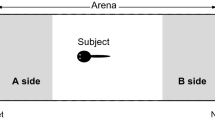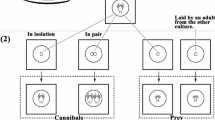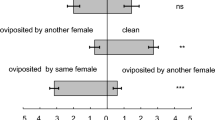Summary
We investigated kin recognition by larval wood frogs (Rana sylvatica) in blind laboratory experiments using spatial affinity as a recognition assay. Tadpoles reared with full-sibs displayed a significant preference for familiar full-sibs over unfamiliar non-kin, but failed to discriminate between unfamiliar full-sibs and unfamiliar paternal half-sibs. Tadpoles reared in social isolation (with or without maternal egg jelly) from the two-celled embryonic stage displayed a significant preference for unfamiliar full-sibs over unfamiliar non-kin. Tadpoles reared on a meat diet with their full-sibs: 1) exhibited a significant preference for unfamiliar full-sibs fed meat over unfamiliar non-kin fed meat, 2) failed to discriminate between unfamiliar full-sibs fed lettuce and unfamiliar non-kin fed meat, 3) exhibited a significant preference for unfamiliar non-kin fed meat over unfamiliar non-lin fed lettuce, 4) failed to discriminate between unfamiliar full-sibs fed meat and unfamiliar full-sibs fed lettuce, and 5) displayed a significant spatial preference for odors associated with meat (a familiar food) over odors associated with lettuce (an unfamiliar food). Our results, together with those of Cornell et al. (1989), indicate that the recognition cue of larval R. sylvatica has both genetic and environmental (dietary) components. Our findings establish that previous exposure to maternal egg jelly, kin, or conspecifics is not necessary for the development of kin recognition ability in larval R. sylvatica. Our results are more consistent with the self-learning of recognition cues (a form of phenotype matching) than with a recognition mechanism that involves a genetically fixed recognition template. Finally, our results indicate that increasing similarity between the recognition template and perceived cue does not necessarily result in increasing spatial affinity for kin.
Similar content being viewed by others
References
Alexander RD, Borgia G (1978) Group selection, altruism, and the levels of organization of life. Ann Rev Ecol Syst 9:449–474
Berven KA (1981) Mate choice in the wood frog, Rana sylvatica. Evolution 35:707–722
Blaustein AR (1983) Kin recognition mechanisms: Phenotypic matching or recognition alleles. Am Nat 121:749–754
Blaustein AR, O'Hara RH (1981) Genetic control for sibling recognition. Nature 290:246–248
Blaustein AR, O'Hara RH (1982a) Kin recognition cues in Rana cascadae tadpoles. Behav Neural Biol 36:77–87
Blaustein AR, O'Hara RH (1982b) Kin recognition in Rana cascadae tadpoles: Maternal and paternal effects. Anim Behav 30:1151–1157
Blaustein AR, O'Hara RH (1986a) An investigation of kin recognition in red-legged frog (Rana aurora) tadpoles. J Zool (London) (A) 209:347–353
Blaustein AR, O'Hara RH (1986b) Kin recognition in tadpoles. Sci Am 154:108–116
Blaustein AR, Bekoff M, Daniels TJ (1987) Kin recognition in vertebrates (excluding primates): Part II. Mechanisms, functions and future research. In: Fletcher DJC, Michener CD (eds) Kin recognition in animals, John Wiley and Sons, NY, pp 333–357
Briggs JL (1987) Breeding biology of the Cascade frog, Rana cascadae, with comparisons to R. aurora and R. pretiosa. Copeia 1987:241–245
Cornell TJ, Berven KA, Gamboa GJ (1989) Kin recognition by tadpoles and froglets of the wood frog, Rana sylvatica. Oecologia 78:312–316
Fishwild TG, Schemidt RA, Jankens KM, Berven KA, Gamboa GJ, Richards CM (1990) Sibling recognition by larval frogs (Rana pipiens, R. sylvatica and Pseudacris crucifer). J Herpetol 24:40–44
Gusseck DJ, Hedrick JL (1971) A molecular approach to fertilization. Dev Biol 25:337–347
Holmes WG, Sherman PW (1983) Kin recognition in animals. Am Sci 71:46–55
Howard RD (1980) Mating behavior and mating success in wood frogs, Rana sylvatica. Anim Behav 28:705–716
Howard RD, Kluge AG (1985) Proximate mechanisms of sexual selection in wood frogs. Evolution 39:260–277
Pfennig DW (1990) “Kin recognition” among spadefoot toad tadpoles: a side-effect of habitat selection. Evolution 44:785–798
Rugh R (1962) The frog, its reproduction and development. McGraw-Hill, NY, p 501
Smith-Gill SJ, Berven KA (1980) In vitro fertilization and assessment of male reproductive potential using mammalian gonadotropin-releasing hormone to induce spermiation in Rana sylvatica. Copeia 4:723–728
Sype WE (1975) Breeding habits, embryonic thermal requirements and embryonic and larval development of the cascade frog, Rana cascadae slater. Ph. D. thesis, Oregon State University
Taylor AC, Kollros JJ (1946) Stages in the normal development of Rana pipiens larvae. Anat Rec 14:7–24
Waldman B (1981) Sibling recognition in toad tadpoles: The role of experience. Z Tierpsychol 56:341–358
Waldman B (1982) Adaptive significance of communal oviposition in wood frogs (Rana sylvatica) Behav Ecol Sociobiol 10:169–174
Waldman B (1984) Kin recognition and sibling association among wood frog (Rana sylvatica) tadpoles. Behav Ecol Sociobiol 14:171–180
Waldman B (1985) Olfactory basis of kin recognition in toad tadpoles. J Comp Physiol 156:565–577
Waldman B (1986) Chemical ecology of kin recognition in anuran amphibians. In: Duvall D, Muller-Schwarze D, Silverstein RM (eds) Chemical signals in vertebrates 4, Plenum Press, NY, pp 225–242
Waldman B (1990) Kin recognition in amphibians. In: Hepper PG (ed) Kin recognition. Cambridge University Press, Cambridge
Author information
Authors and Affiliations
Rights and permissions
About this article
Cite this article
Gamboa, G.J., Berven, K.A., Schemidt, R.A. et al. Kin recognition by larval wood frogs (Rana sylvatica): effects of diet and prior exposure to conspecifics. Oecologia 86, 319–324 (1991). https://doi.org/10.1007/BF00317596
Received:
Accepted:
Issue Date:
DOI: https://doi.org/10.1007/BF00317596




